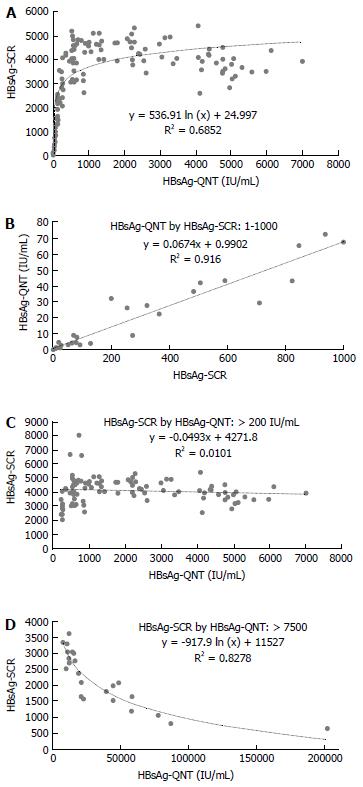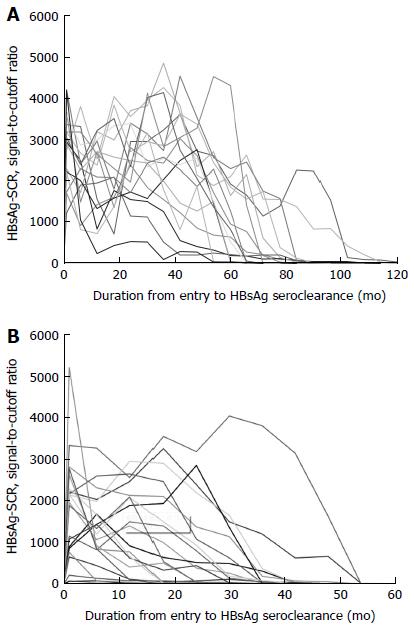Copyright
©The Author(s) 2016.
World J Gastroenterol. Nov 28, 2016; 22(44): 9836-9843
Published online Nov 28, 2016. doi: 10.3748/wjg.v22.i44.9836
Published online Nov 28, 2016. doi: 10.3748/wjg.v22.i44.9836
Figure 1 Signal-to-cutoff ratio of hepatitis B surface antigen was measured by qualitative assay and partially reflects the quantity of hepatitis B surface antigen in the serum.
A: There was a log-linear correlation between the HBsAg-SCR and HBsAg-QNT; B: There was a good correlation with a linear drift curve between an HBsAg-SCR < 1000 and an HBsAg-QNT < 100 IU/mL (y = 0.0674x + 0.9902, R² = 0.916); C: HBsAg-QNT levels of greater than 200 IU/mL were not correlated with the HBsAg-SCR; D: Very high HBsAg titers of more than 10000 IU/mL were inversely correlated with the HBsAg-SCR, which was caused by a prozone effect. HBsAg-SCR: Signal-to-cutoff ratio of HBsAg; HBsAg-QNT: Quantity of HBsAg; HBsAg: Hepatitis B surface antigen.
Figure 2 Sequential changes in the signal-to-cutoff ratio of Hepatitis B surface antigen in the patients with negative conversion of Hepatitis B surface antigen during the follow-up period after registration.
A: HBsAg-SCRs in the patients with HBsAg-NC after 5 years post-entry; B: HBsAg-SCRs in the patients with HBsAg-NC before 5 years post-entry. HBsAg-SCR: Signal-to-cutoff ratio of HBsAg; HBsAg-NC: Negative conversion of HBsAg; HBsAg: Hepatitis B surface antigen.
- Citation: Park YM, Lee SG. Clinical features of HBsAg seroclearance in hepatitis B virus carriers in South Korea: A retrospective longitudinal study. World J Gastroenterol 2016; 22(44): 9836-9843
- URL: https://www.wjgnet.com/1007-9327/full/v22/i44/9836.htm
- DOI: https://dx.doi.org/10.3748/wjg.v22.i44.9836














